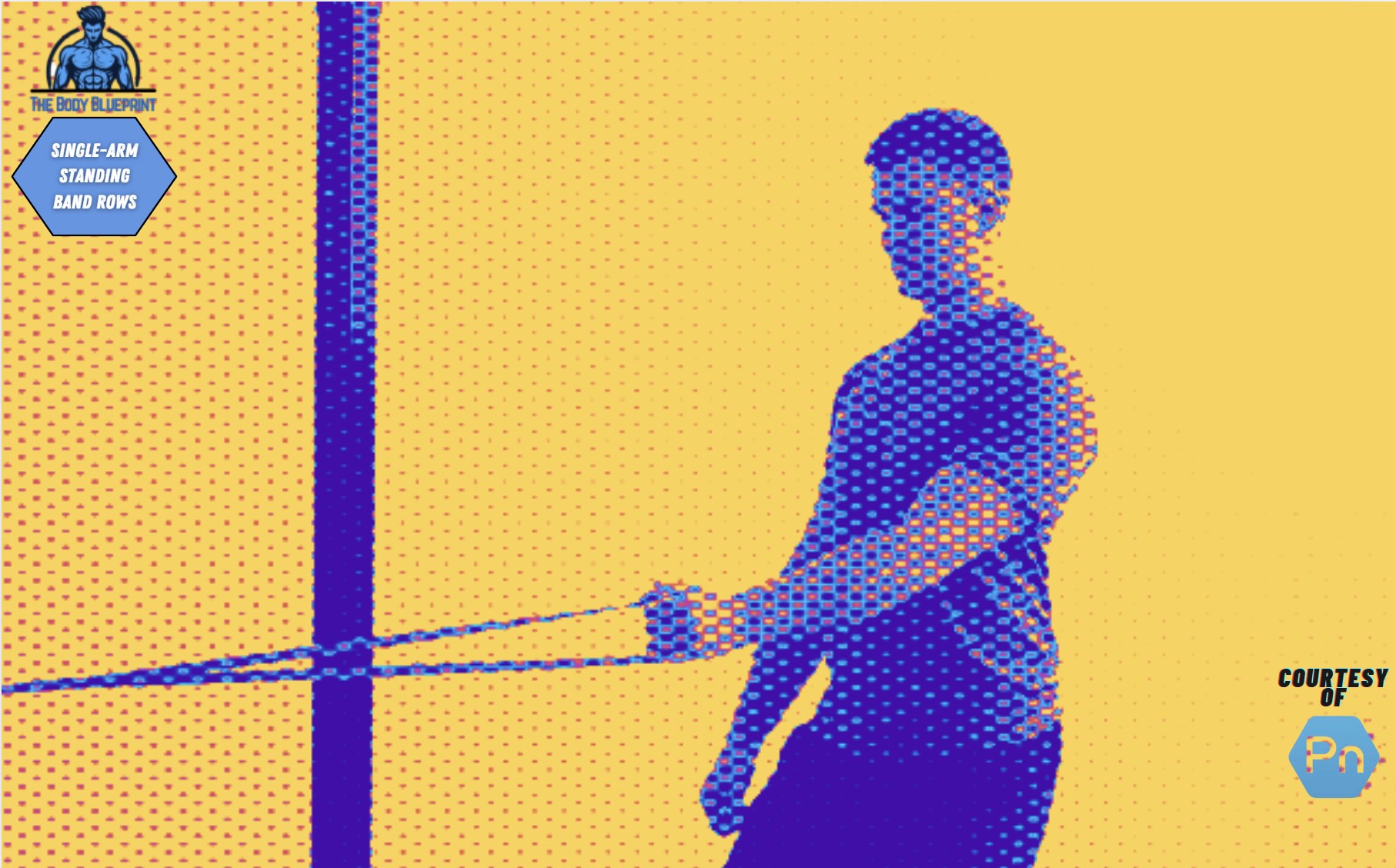Picture this: you’re standing tall, gripping a resistance band like it holds the secret to superhero-level lats. You pull it back, feeling your upper body engage in ways that say, “Yeah, this is functional strength in action.” That’s the magic of the single-arm standing band row—a no-frills, high-results move that makes your muscles pop and your posture proud.
Let’s break it down, one rep at a time.
What Are Single-Arm Standing Band Rows?
Single-arm standing band rows are a resistance band exercise designed to target your back muscles, particularly your lats, traps, and rhomboids. Unlike machine or barbell rows, the standing variation adds a core-strengthening element, forcing you to stabilize your entire body while isolating one side.
The result? A balanced, ripped physique and functional strength you can flex in the gym—or the real world.
Muscles Worked: Why It’s More Than Just Your Back
When you perform a single-arm standing band row, you’re recruiting way more than just your lats. Here’s the breakdown:
| Muscle Group | Primary Role |
|---|---|
| Latissimus Dorsi (Lats) | Main driver of the pulling motion. |
| Trapezius (Traps) | Stabilizes your shoulder during the row. |
| Rhomboids | Squeezes your shoulder blades together. |
| Biceps | Assists with elbow flexion. |
| Core | Keeps you stable and prevents rotation. |
It’s like a full-body workout disguised as a back exercise.
Performing Single-Arm Standing Band Rows
You don’t need a fancy gym setup to crush this move—just a resistance band and a sturdy anchor point.
Step-by-Step Instructions
- Set Up the Band: Anchor the band at chest height (a door, pole, or heavy object works).
- Grip and Stance: Stand facing the anchor with your feet shoulder-width apart. Grab the band with one hand, arm extended.
- Engage Your Core: Brace your abs like you’re preparing for a gut punch.
- Pull: Drive your elbow back, keeping it close to your side. Squeeze your shoulder blade at the top.
- Control the Return: Slowly release the band until your arm is fully extended.
Pro tip: Avoid twisting your torso—keep the movement locked in your upper body.
Benefits of Single-Arm Standing Band Rows
This exercise doesn’t just build your back; it transforms how you move, stabilize, and perform in everyday life.
- Functional Strength: Enhances pulling power for sports, lifting, and daily tasks.
- Core Stability: Challenges your abs and obliques to keep you upright.
- Corrects Imbalances: Fixes left-to-right strength disparities.
- Low Impact: A joint-friendly way to build muscle and endurance.
- Versatile: Perfect for home workouts, travel, or warming up at the gym.
Whether you’re carrying groceries, slinging a backpack, or pulling off a one-arm pull-up (eventually), this move sets you up for success.
Common Mistakes to Avoid
Don’t let poor form rob you of gains. Here’s what to watch out for:
- Twisting Your Torso: This takes the focus off your back and core.
- Shrugging Your Shoulders: Engage your lats, not your traps.
- Relying on Momentum: Control the movement; don’t let the band pull you around.
- Skipping the Core Engagement: Tighten those abs to stay steady.
Variations to Keep It Fresh
Boredom kills consistency, so mix it up with these tweaks:
- Kneeling Single-Arm Band Rows: Reduces leg involvement, increasing core isolation.
- High Anchor Rows: Attach the band higher to shift emphasis to your traps.
- Low Anchor Rows: Target your lower lats with a downward pull.
- Tempo Rows: Slow down the pull and return for maximum time under tension.
Sample Workout Plan: Maximize Your Gains
Incorporate single-arm standing band rows into your weekly routine:
| Day | Sets | Reps | Notes |
|---|---|---|---|
| Back Day | 3 | 10-12 | Focus on form, not speed. |
| Full Body | 2 | 15 | Pair with push-ups for balance. |
| Core Day | 3 | 8-10 | Use a heavier band for extra tension. |
Why Resistance Bands Are a Game-Changer
Resistance bands offer unique benefits compared to dumbbells or barbells:
| Feature | Resistance Bands | Weights |
|---|---|---|
| Portability | Travel-friendly and lightweight. | Bulky and fixed in one place. |
| Variable Resistance | Tension increases as you stretch. | Fixed resistance. |
| Joint-Friendly | Smooth, controlled movements. | Can strain joints under load. |
| Versatility | Works for countless exercises. | Limited without machines. |
FAQ: Your Burning Questions Answered
1. Can beginners do this exercise?
Absolutely! Start with a lighter band and focus on mastering the form.
2. How often should I do single-arm standing band rows?
Include them 2-3 times a week as part of a balanced training plan.
3. How do I choose the right band?
Opt for a medium-resistance band that challenges you without compromising form.
4. Can I build muscle with just bands?
Yes! Bands create variable resistance, which can stimulate muscle growth when paired with progressive overload.
Final Pull
The single-arm standing band row is more than just an exercise—it’s a ticket to a stronger, more balanced body. With minimal equipment and maximum benefits, it’s the kind of move that fits anywhere in your routine. So grab a band, plant your feet, and start pulling your way to greatness.

